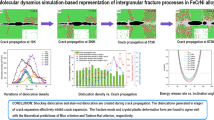Abstract
The molecular dynamics method has been used to simulate mode I cracking in body-centered-cubic iron. Close attention has been paid to the process of the atomic configuration evolution of the cracks. The simulation shows that at low temperatures, partial dislocations are emitted before the initiation of crack propagation, subsequently forming the stacking faults or multilayer twins on {112} planes, and then brittle cleavage and extended dislocation nucleation are observed at the crack tip accompanied by twin extension. These results are in agreement with the experimental observation that twinning and fracture processes cooperate at low temperatures. Furthermore, an energetics analysis has been made on the deformation behavior observed at the crack tip. The effect of temperature on the fracture process is discussed. At the higher temperature, plastic deformation becomes easier, and crack blunting occurs. With increasing temperature, the fracture resistance increases, and the effect of the lattice trapping can be weakened by thermal activation.
Similar content being viewed by others
References
A. Kelly, W.R. Tyson, A.H. Cottrell: Ductile and brittle crystals. Philos. Mag. 15, 567 (1967).
J.R. Rice, R. Thomson: Ductile versus brittle behaviour of crystals. Philos. Mag. 29, 73 (1974).
J.R. Rice: Dislocation nucleation from a crack tip: An analysis based on the peierls concept. J. Mech. Phys. Solids 40, 239 (1992).
J.R. Rice, G.E. Beltz: The activation energy for dislocation nucleation at a crack. J. Mech. Phys. Solids 42, 333 (1994).
P.B. Hirsch, S.G. Roberts: Comment on the brittle-to-ductile transition: A cooperative dislocation generation instability; dislocation dynamics and the strain-rate dependence of the transition temperature. Acta Mater. 44, 2361 (1996).
A. Hartmaier, P. Gumbsch: On the activation energy for the brittle/ductile transition. Phys. Status Solidi B 202, R1 (1997).
P. Gumbsch, J. Riedle, A. Hartmaier, H.F. Fischmeister: Controlling factors for the brittle-to-ductile transition in tungsten single crystals. Science 282, 1293 (1998).
S.M. Ohr: An electron microscope study of crack tip deformation and its impact on the dislocation theory of fracture. Mater. Sci. Eng. 72, 1 (1985).
M.J. Lii, X.F. Chen, Y. Katz, W.W. Gerberich: Dislocation modeling and acoustic emission observation of alternating ductile/brittle events in Fe-3wt%Si crystals. Acta Metall. Mater. 38, 2435 (1990).
W. Zielinski, M.J. Lii, W.W. Gerberich: Crack-tip dislocation emission arrangements for equilibrium—I. In situ TEM observations of Fe-2wt%Si. Acta Metall. Mater. 40, 2861 (1992).
A. Machová, G.E. Beltz, M. Chang: Atomistic simulation of stacking fault formation in bcc iron. Model. Simul. Mater. Sci. Eng. 7, 949 (1999).
D. Farkas, M. Duranduru: Multiple-dislocation emission from the crack tip in the ductile fracture of Al. Philos. Mag. A 81, 1241 (2001).
D. Hull: Twinning and fracture of single crystals of 3% silicon iron. Acta Metall. 8, 11 (1960).
A.W. Sleeswyk: Twinning and the origin of cleavage nuclei in α-iron. Acta Metall. 10, 803 (1962).
K. Ogawa: Edge dislocations dissociated in 112 planes and twinning mechanism of b.c.c. metals. Philos. Mag. 11, 217 (1965).
J. Bošanský, T. Šmida: Deformation twins–Probable inherent nuclei of cleavage fracture in ferritic steels. Mater. Sci. Eng., A 323, 198 (2002).
B. deCelis, A.S. Argon, S. Yip: Molecular dynamics simulation of crack tip processes in alpha-iron and copper. J. Appl. Phys. 54, 4864 (1983).
K.S. Cheung, S. Yip: A molecular-dynamics simulation of crack-tip extension: The brittle-to-ductile transition. Model. Simul. Mater. Sci. Eng. 2, 865 (1994).
S.Y. Hu, M. Ludwig, P. Kizler, S. Schmauder: Atomistic simulations of deformation and fracture of α–Fe. Model. Simul. Mater. Sci. Eng. 6, 567 (1998).
S. Hai, E.B. Tadmor: Deformation twinning at aluminum crack tips. Acta Mater. 51, 117 (2003).
M.W. Finnis, J.E. Sinclair: A simple empirical N-body potential for transition metals. Philos. Mag. A. 50, 45 (1984).
M.W. Finnis, J.E. Sinclair: Erratum. Philos. Mag. A. 53, 161 (1986).
G.C. Sih, H. Liebowitz: Mathematical theories of brittle fracture, in Fracture: An Advanced Treatise, Vol. 2, edited by H. Liebowitz (Academic Press, New York, 1968), pp. 108–125.
L. Hua, H. Rafii-Tabar, M. Cross: Molecular dynamics simulation of fractures using an N-body potential. Philos. Mag. Lett. 75, 237 (1997).
A. Machová, G.J. Ackland: Dynamic overshoot in α-iron by atomistic simulations. Model. Simul. Mater. Sci. Eng. 6, 521 (1998).
M.P. Allen, D.J. Tildesley: Computer Simulation of Liquids (Oxford University Press, New York, 1987), p. 83.
R. Thomson, C. Hsieh, V. Rana: Lattice trapping of fracture cracks. J. Appl. Phys. 42, 3154 (1971).
D. Hull, D.J. Bacon: Introduction to Dislocations, 3rd ed. (Pergamon Press, New York, 1984), p. 7.
N.H. Macmillan: The ideal strength of solids, in Atomistics of Fracture, edited by R.M. Latanision and J.R. Pickens, (Plenum Press, New York, 1983), p. 111.
J. Frenkel: The theory of the elastic limit and the hardness of crystalline body. Z. Phys. 37, 572 (1926).
T.C. Wang: Fracture criteria for combined cleavage and dislocation emission. Philos. Mag. A 74, 983 (1996).
A. Latapie, D. Farkas: Molecular dynamics investigation of the fracture behavior of nanocrystalline α–Fe. Phys. Rev. B 69, 134110 (2004).
Author information
Authors and Affiliations
Corresponding author
Rights and permissions
About this article
Cite this article
Cao, LX., Wang, CY. Atomistic simulation for configuration evolution and energetic calculation of crack in body-centered-cubic iron. Journal of Materials Research 21, 2542–2549 (2006). https://doi.org/10.1557/jmr.2006.0307
Received:
Accepted:
Published:
Issue Date:
DOI: https://doi.org/10.1557/jmr.2006.0307




